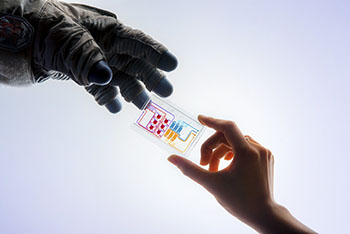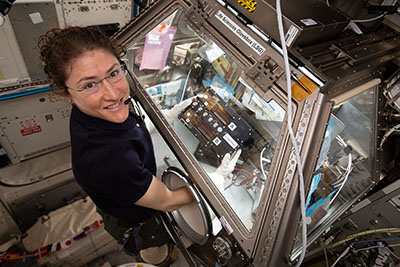NIH Science in Orbit
Tissue Chips in Space

CREDIT: NASA
The International Space Station serves as a research lab for NIH-funded researchers studying the effects of accelerated aging on human health.
Both intramural and extramural NIH scientists are using the special environment of space to gather new insights into human health. Symptoms of accelerated aging and many health conditions, such as immune-system changes and bone and muscle loss, occur more rapidly in space due to the effects of microgravity (diminished or close-to-zero gravity). Microgravity greatly facilitates studies that could take much longer to carry out on Earth.
“NIH scientists have an amazing opportunity to model diseases and investigate potential treatments for them at the International Space Station,” said Lucie Low, the NIH-NASA liaison point-of-contact and a scientific program manager at the National Center for Advancing Translational Sciences (NCATS). “NIH has a long history of collaborating with NASA, and I see lots of exciting opportunities for our researchers to continue doing so over the coming years.” The two organizations have been collaborating since the early 1960s. NIH’s role in the collaboration, which includes many institutes and centers, was first led by the National Institute of Arthritis and Musculoskeletal and Skin Diseases, later by the National Institute of Biomedical Imaging and Bioengineering (NIBIB), and today by NCATS.
To illustrate the usefulness of NIH science-in-space, here’s a quick look at the projects that NCATS and the National Cancer Institute (NCI) launched from Cape Canaveral, Florida, to the International Space Station U.S. National Laboratory (abbreviated as ISS National Laboratory) on May 4, 2019. The projects are now back on the ground, and researchers are analyzing the results.
Tissue Chips in Space
NCATS sent up four miniature tissue-chip systems to better understand aging-related conditions and diseases, speed up the development of interventions to treat them, and enable wider use of tissue-chip technology on the ground.

CREDIT: BIOLINES LABORATORY, UNIVERSITY OF PENNSYLVANIA
A lung–bone marrow tissue chip in space will help researchers explore how the body fights infection.

CREDIT: NASA
International Space Station U.S. National Lab’s Expedition 59 crewmember Christina Koch assisted with the kidney-tissue chips in space research.
Tissue chips, also known as organs-on-chip, are tiny, bioengineered three-dimensional models that mimic the structure and function of human organs such as the heart, kidneys, and lungs. Scientists use tissue chips to study diseases and test the possible effects of drugs on those tissues.
The projects on the May 2019 mission are part of the Tissue Chips in Space Initiative, a collaborative program involving NCATS, NIBIB, and the ISS National Laboratory, which partners with NASA to use the U.S. portion of the space station for research.
This launch was the second time NIH-funded tissue-chip experiments flew on the ISS. The first was in December 2018 with immune-system tissue chips developed by researchers at the University of California, San Francisco. The NIH-funded projects on this May 2019 mission included kidney chips, bone and cartilage chips, lung and bone-marrow chips, and chips modeling the blood–brain barrier. Each project has direct clinical applications to health conditions we experience on Earth. For example, findings from the lung and bone-marrow chips will directly relate to how aging affects our ability to fight infection. Findings from the kidney-chip models could yield clues to the cause, prevention, and treatment of aging-related conditions affecting the kidneys. And the blood–brain barrier chips will enable researchers to look at neurodegenerative diseases.
To get the projects ready for the ISS, the scientific teams collaborated with engineers to shrink a roomful of lab equipment into “plug-and-play” shoebox-sized packages that could accommodate space limitations, stand the stress of space flight, and be operated by astronauts and pilots who don’t know the research.
Each tissue-chip project will fly into orbit twice. The initial group of tissue chips were aboard the ISS National Lab for about a month before returning to Earth. In 2020, the chips will be sent back to the space station so potential drug therapies can be tested on the biological processes observed during the first visit to the space.
To read more about the tissue chips in space project, go to https://ncats.nih.gov/tissuechip/projects/space. If you’re interested in sending a project into space, please email Lucie Low at Lucie.Low@nih.gov.
This page was last updated on Saturday, January 18, 2025
